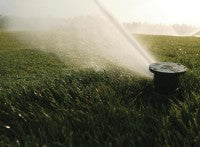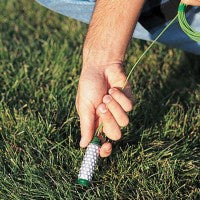Irrigation for the future - should brown be the new green?
 "Gone are the days when quantities of unmentionable chemicals raped the soil fauna and microorganisms, leaving the rootzone inert"
"Gone are the days when quantities of unmentionable chemicals raped the soil fauna and microorganisms, leaving the rootzone inert"
One thing is one hundred percent certain, water is essential for plant survival. I use the term survival and not growth intentionally; as we are not farmers, we do not look for yield in our grass harvest, but a delicate balance between growth and playing quality. Over 90% of plant tissue is made up from the life giving liquid, it also contributes to cooling the plant, keeping it turgid and acts as a vital transport system for nutrients and chemicals around the plant.
It is my endeavour, in this article, to look at 'water conservation and usage in the future' - in the short, medium and long term.
In the short term, follow the principals of 'Best Practice', and the development of exemplary cultural practices. Perhaps, you might say it is not within my remit to discuss cultural operations, but I would be failing in my duty if I were not to mention such considerations.
 It goes without saying that aeration is arguably top of the list. Deep aeration, by whatever means, will increase the root biomass, encourage deep rooting and present the sward with a greater opportunity to search for available water. On the other hand, surface aeration, and the constant strive to control thatch, will encourage greater infiltration and allow vital dew to penetrate the rootzone before it is burned off and evaporated as the sun rises. The use of wetting agents and the benefits of switching will assist in the harvest of this small, but vital, free supply of water.
It goes without saying that aeration is arguably top of the list. Deep aeration, by whatever means, will increase the root biomass, encourage deep rooting and present the sward with a greater opportunity to search for available water. On the other hand, surface aeration, and the constant strive to control thatch, will encourage greater infiltration and allow vital dew to penetrate the rootzone before it is burned off and evaporated as the sun rises. The use of wetting agents and the benefits of switching will assist in the harvest of this small, but vital, free supply of water.
Raising the height of cut, and even leaving the clippings to act as a mulch, will play yet another small, but significant, part in moisture conservation - but this may not sit too well with some of the membership - whilst clean sharp cylinders will minimise leaf wounding.
The use of growth regulating chemicals are now increasingly common in turf management regimes, reducing the internodal length of grasses, producing denser swards and greater root biomass; seaweed extracts and soil ameliorants playing their part in the general awareness of rootzone quality. Gone are the days when quantities of unmentionable chemicals raped the soil fauna and microorganisms, leaving the rootzone inert.
Although perhaps not in the short term, rather medium or even long term, changing and influencing the composition of the sward towards a greater tolerance to drought resistance and salt tolerance could be achieved by gradual overseeding with new and developing cultivars.
A look at all these factors and more can have, albeit small, a significant influence on the conservation of water supplies.
Turning our attention to the application of water and the irrigation system, much can still be achieved by checking the system thoroughly during the off season. Do the pop-up sprinklers actually pop-up, are they rotating, have any been damaged by winter aeration procedures, is the spacing of the sprinkler heads correct and do the pop-ups have the correct nozzles to provide adequate head to head coverage. Simple measures, but you would be amazed how often these common problems occur.
Poor spacing of sprinkler heads is perhaps the commonest problem. Without head to head contact, accurate distribution of water is not possible. Poor spacing may be the fault of the initial installation, or may be the fact that the green shape, over time, has changed. Arc settings should be studied and checked annually, as should the actual water pressure at the sprinkler head. This information can lead to the discovery of leaks within the system or the change of nozzles to achieve the desired outcome.
 When the system is a block design, as experienced often with the traditional design of tees and greens, then each pair of sprinklers will deliver water for the same length of time. Where there has been an on-site modification to allow, for example, aprons to be irrigated, both sprinkler arcs must be the same, for if one is full circle and the other part circle, the full circle will be delivering 50% less water than the part circle in any given time.
When the system is a block design, as experienced often with the traditional design of tees and greens, then each pair of sprinklers will deliver water for the same length of time. Where there has been an on-site modification to allow, for example, aprons to be irrigated, both sprinkler arcs must be the same, for if one is full circle and the other part circle, the full circle will be delivering 50% less water than the part circle in any given time.
In the medium term, and each of the rather arbitrary terms will overlap, we must look at education and training. As irrigation is often said to be 'out of sight out of mind', at least one member of staff should be fully trained in the management of the said system. After all, a new system will, arguably, be the most costly piece of equipment in which a club will invest. When a new system is installed, a full training course is offered on the operation and management of the hardware. This is essential as, on returning to previous sites, so often, the system is set up in the way it was on the first day, with little regard for current environmental conditions. Trained staff should be able to calculate sprinkler run times to coincide with the desired application rate, and operate the system to its full potential. Courses on this are held each year as Workshops for CPD at BTME.
But, it is not just the greenstaff who should appreciate the need for knowledge regarding the use of water. The membership of the club should also be aware of the dangers of over irrigating.
 With the intervention of CAMS and the Water Framework Directive, water usage in the future is fast becoming a political issue, and indiscriminative water usage will be a thing of the past.
With the intervention of CAMS and the Water Framework Directive, water usage in the future is fast becoming a political issue, and indiscriminative water usage will be a thing of the past.
Water audits and the justification for the continued use of potable water will become yet another chore for the Course Manager. Proper accountability, the maintenance of records of water usage and the justification for that usage is unquestionably on the way.
In the long term, modern technology must be employed to save the day. Club committees should decide on which areas of the golf course are to be irrigated, modern design can be area specific, whether that be simply tees and greens or whether it is to encompass fairways, approaches and walkways. Good design can save water and take into account the need for the conservation of the peripheral landscape.
It may not be necessary to sell off the family silver to plan and put into operation a new irrigation system. Provided the overall plan is discussed and approved by all concerned, the grand-plan should incorporate all future requirements. A phased development can then be put into operation installing, initially, greens and tees, but with adequate pipework, cabling infrastructure and pumping capacity to allow for future expansion to encompass aprons, fairways and walkways.
Balancing the infiltration rate with the application rate, and the incorporation of a correctly positioned weather station and soil moisture censors, along with traditional ways of observing soil moisture deficit, can be demonstrated to be effective in managing water, some estimates suggesting as much as a 20% saving.
However, we should also take into consideration, when planning and designing any system, the complex issues of water resourcing. On the Continent, some countries are already restricting the annual quantity of water which it is permissible to use. In Denmark, for instance, some courses are restricted to as little as 5,000m3 per year. Borehole usage will be controlled by the local CAMS and restrictions may apply in the future.
Water collection and the provision of water storage facilities will be essential in future planning. Continued use of potable water from the public water system will, undoubtedly, and at the very least, become prohibitively expensive, if not denied.
Climate change is, indeed, another complex issue, and speculation varies widely. However, over the past few years, few will disagree that the pattern of climate has tended to be more extreme, in particular heavier but less frequent rainfall, for instance. In this area, we must look to the long term to secure our water resourcing and install some form of water storage facility.
For a relatively simple greens and tees system in the UK, a storage capacity of some 10,000-15,000m3 should be adequate but, if expansion is planned for the future, then 25,000-40,000m3 may be required. We also need to explore the sourcing of that water.
Water farming and collection of water from the golf course, via drainage, hard standing areas such as car parks should be considered if the site is suitable. Recycling non-soiled clubhouse water through reed beds and ultra violet filters is another. Licence of extraction from bore holes, rivers and streams is yet another possibility. This really is long term planning, and to discuss it should not be procrastinated. Remember that degree in foresight I spoke of earlier.
In conclusion; yes, there are some relatively simple measures which can be implemented to conserve water and improve our irrigation procedures. Demonstrating to the water companies you are being proactive in your water management is a good start. Maintain records, monitor application, have service records for the irrigation system, engage in education and have and carry out a water audit.
There are, however, also some difficult choices ahead which I have tried to highlight.
Adrian Mortram is Managing Director of Robin Hume Associates (RHA) who are golf course and sportsturf irrigation consultants based in the UK. RHA offer a range of services from irrigation audits through to detailed design, plans and specifications. For more information please visit www.irrigationconsultants.co.uk, or email adrian.mortram@irrigationconsultants.co.uk
